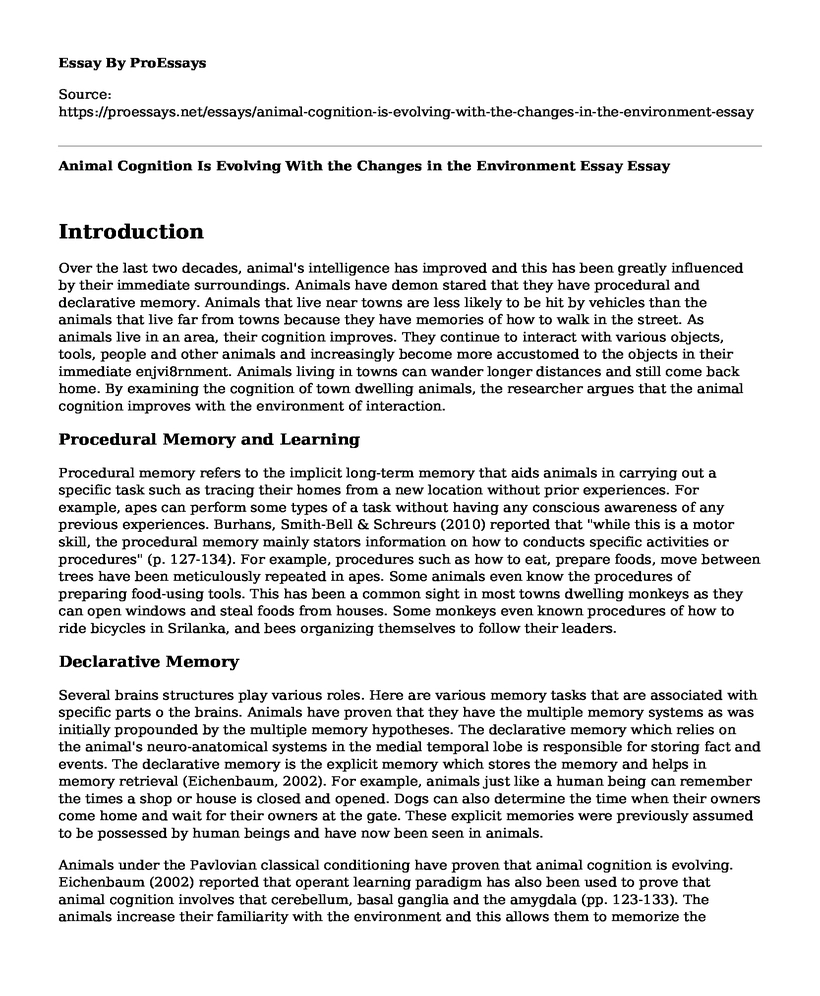Introduction
Over the last two decades, animal's intelligence has improved and this has been greatly influenced by their immediate surroundings. Animals have demon stared that they have procedural and declarative memory. Animals that live near towns are less likely to be hit by vehicles than the animals that live far from towns because they have memories of how to walk in the street. As animals live in an area, their cognition improves. They continue to interact with various objects, tools, people and other animals and increasingly become more accustomed to the objects in their immediate enjvi8rnment. Animals living in towns can wander longer distances and still come back home. By examining the cognition of town dwelling animals, the researcher argues that the animal cognition improves with the environment of interaction.
Procedural Memory and Learning
Procedural memory refers to the implicit long-term memory that aids animals in carrying out a specific task such as tracing their homes from a new location without prior experiences. For example, apes can perform some types of a task without having any conscious awareness of any previous experiences. Burhans, Smith-Bell & Schreurs (2010) reported that "while this is a motor skill, the procedural memory mainly stators information on how to conducts specific activities or procedures" (p. 127-134). For example, procedures such as how to eat, prepare foods, move between trees have been meticulously repeated in apes. Some animals even know the procedures of preparing food-using tools. This has been a common sight in most towns dwelling monkeys as they can open windows and steal foods from houses. Some monkeys even known procedures of how to ride bicycles in Srilanka, and bees organizing themselves to follow their leaders.
Declarative Memory
Several brains structures play various roles. Here are various memory tasks that are associated with specific parts o the brains. Animals have proven that they have the multiple memory systems as was initially propounded by the multiple memory hypotheses. The declarative memory which relies on the animal's neuro-anatomical systems in the medial temporal lobe is responsible for storing fact and events. The declarative memory is the explicit memory which stores the memory and helps in memory retrieval (Eichenbaum, 2002). For example, animals just like a human being can remember the times a shop or house is closed and opened. Dogs can also determine the time when their owners come home and wait for their owners at the gate. These explicit memories were previously assumed to be possessed by human beings and have now been seen in animals.
Animals under the Pavlovian classical conditioning have proven that animal cognition is evolving. Eichenbaum (2002) reported that operant learning paradigm has also been used to prove that animal cognition involves that cerebellum, basal ganglia and the amygdala (pp. 123-133). The animals increase their familiarity with the environment and this allows them to memorize the environment, specific strategies of getting their food and continue to develop a habit. The classically conditioned eyeblink response in animals is also associated with improved animal cognition (Burhans, Smith-Bell & Schreurs, 2010)
Conclusion
While the declarative memory relies on the neuro-anatomical system, the procedural memory of animals is tasked with the acquisition, consolidation as well as retrieval of the most important and context-dependent memory. The explicit and implicates memories clearly prove that animals are slowly evolving and their cognition or intelligence is also improving by the day. The hippocampus links the representations of various overlapping experiences in one relational representation. The representation supports the flexible and inferential expression of an indirect association between different items and among numerous objects within the environment.
References
Burhans, L., Smith-Bell, C., & Schreurs, B. (2010). Effects of extinction on classical conditioning and conditioning-specific reflex modification of rabbit heart rate. Behavioral Brain Research, 206(1), 127-134. doi: 10.1016/j.bbr.2009.09.007
Eichenbaum, H. (1992). The Hippocampal System and Declarative Memory in Animals. Journal Of Cognitive Neuroscience, 4(3), 217-231. doi: 10.1162/jocn.1992.4.3.217
Eichenbaum, H. (1999). The hippocampus and mechanisms of declarative memory. Behavioral Brain Research, 103(2), 123-133. doi: 10.1016/s0166-4328(99)00044-3
Cite this page
Animal Cognition Is Evolving With the Changes in the Environment Essay. (2022, Nov 20). Retrieved from https://proessays.net/essays/animal-cognition-is-evolving-with-the-changes-in-the-environment-essay
If you are the original author of this essay and no longer wish to have it published on the ProEssays website, please click below to request its removal:
- Effects of Light Intensity and Carbon Dioxide on Photosynthesis
- The Social Behavior and Roles of Specific Primate Groups
- Problems of the Male Reproductive System
- Impacts of Genetic Engineering on Agricultural Production Essay
- Birds Show Cognitive Attributes on Par With Mammals - Essay Sample
- Essay on Everglades Restoration: A Decade-Long Process of Environmental Restoration
- Understanding Varicose Vein Problems - Free Report Example







